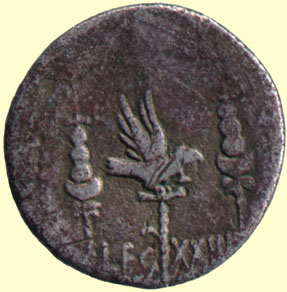 Contents -
Previous Article -
Next Article
Contents -
Previous Article -
Next Article
In 31 BC the outcome of a sea battle off the West coast of Greece forever changed Roman history. As a result, the young and ambitious Octavian would become Rome's first emperor, Augustus. Octavian's victory firmly established his military power and dealt Marc Antony a serious defeat from which he would never recover. This battle took place between Octavian's fleet on one side and the combined naval forces of Marc Antony and Cleopatra VII in the other. The battle is considered a major turning point in the history of Egypt and marked the beginning of Octavianís complete takeover of the rich North African kingdom. Octavian was given the title of Augustus by the Roman Senate four years later.
The struggle between Antony and Octavian was actually about the question of who would rule the Roman World. Antony had allied himself with Cleopatra, queen of Egypt, a descendent of the Ptolemaic Greek kings. Furthermore, Antony and the foreign queen were lovers, even having gone through an Egyptian wedding ceremony. Most Romans disliked such a close relationship between an important governing Roman and a foreign queen. They suspected that he would either give her a large area of Roman territory for her own kingdom, or, worse yet, make her queen over the Romans and himself king in the process. Octavian played on the Romansíintense dislike of the idea of being ruled by a king and denounced Antonyís supposed plans.
Soon, Antony divorced his legitimane wife Octavia, who was Octavianís sister. It was not long before there was a full scale civil war between the two powerful Romans. Antony had anchored his fleet in a small harbor on the Dalmatian side of the Adriatic sea, and soon Octavianís fleet had him trapped within his harbor. Octavian also had his land armies placed in strategic positions to cut off all supplies to Antonyís army and fleet. Antony also had a large army encamped on the shores of the Ambracian Gulf (on the Dalmatian Coast across the Adriatic Sea from Italy). There had been skirmishes and indecisive battles all throughout the Summer of 31 B. C. Near the end of Summer, Antonyís supplies were getting low and so was the morale of his troops.
Finally, on September 2, Antony came out to fight. His 220 heavy Roman warships were equipped with stone throwing catapults. They attacked Octavianís 260 lighter vessels at close range. Octavianís lighter vessels were more maneuverable, though, and could use their rams more effectively than Antonyís ships could. Also, Octavian had the great advantage of having the brilliant general and military strategist Marcus Agrippa in command of his fleet. Cleopatra had 60 warships in the battle, including her treasure ship with its purple sails.
The fighting continued throughout the day, with stout - hearted legionaries on both sides staining the sea red with Roman blood and killing their fellow citizens in about equal numbers. Then, a very strange thing happened. Cleopatra decided to take her ships and flee. This act of cowardice dealt a serious blow to the morale of Antonyís men and cheered Octavianís sailors on to ultimate victory. The battle was nowhere near lost, there was not even a clear indication of which fleet was winning before Cleopatra cut her cables and ran.
Then, the final blow to Roman morale was struck by Antony himself. Upon seeing his beloved queen fleeing, he chose to abandon his stalwart Roman legions and follow her. After a desperate chase, he finally caught up with her. Meanwhile, Octavianís ships made short work of mopping up Antonyís fleet. Many of Antonyís brave seamen surrendered to Octavian and the battle was over.
The issue was not over for Antony and Cleopatra, however. Over the next few months, Octavianís armies won victory after victory as they advanced through Greece and the East toward Cleopatraís Egypt. Antony's forces fought a hopeless retreat with their armies falling before Octavianís advance on every occasion of battle. More and more men deserted Antony's side and went over to join the victorious army of Octavian. The two lovers soon saw that their cause was lost. Antony tried to commit suicide by falling on his sword. The wound was not immediately fatal and he found the strength to make his way to Cleopatraís tomb, where she was awaiting news of the end also. Antony died in the arms of his lover. Cleopatra, meanwhile, had made plans of her own. Rather than be forced to walk in Octavianís triumphal march through the streets of Rome as a captured foreign queen amid the jeers and insults of the Roman people, she would commit suicide. One of her serving girls brought her a basket of fruit containing a poisonous asp. When Cleopatra heard Octavianís victorious troops noisily milling about the streets of Alexandria, she put the snake to her breast and let it bite her. Her death was supposed to be completely painless. The two serving girls she had with her did likewise and when Octavianís troops entered the tomb, the one girl still alive had barely the strength to tell the soldiers that Cleopatra had escaped them in death before the faithful servant herself expired as well.
And so ends the tragic tale of the last Ptolemaic queen of Egypt and the sea battle upon which turned an empire. The Battle of Actium was not a massive battle between huge fleets; in fact, it was a rather small one. But after the Battle of Actium was won and lost, there was not a single obstacle in the way of Octavian becoming the first Roman emperor, titled Augustus and master of the entire Western world.
Go to next article:
Go back to previous article:
Return to Table of Contents